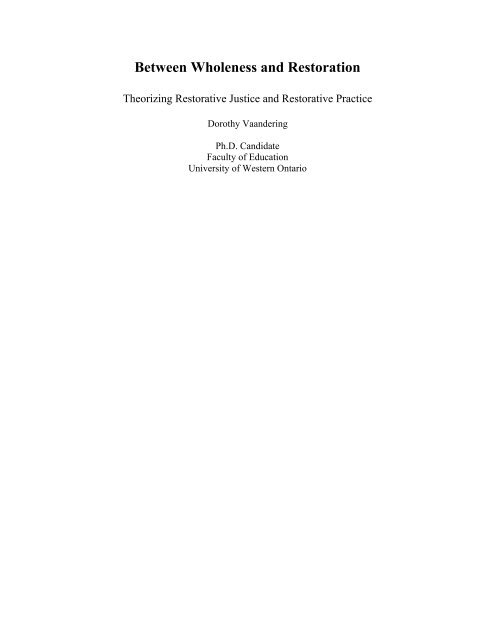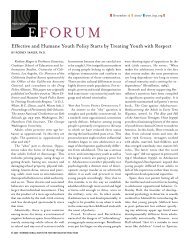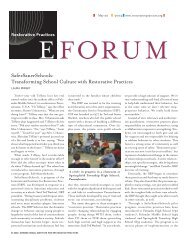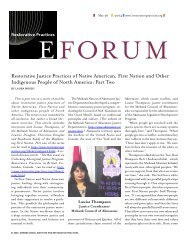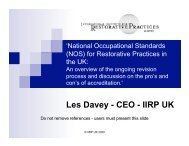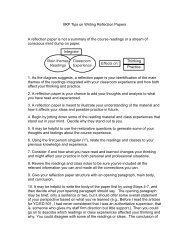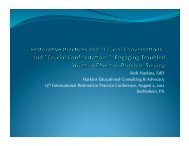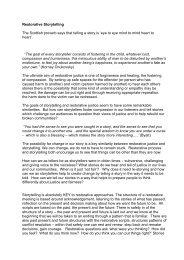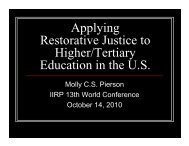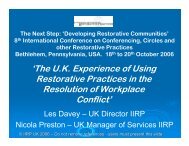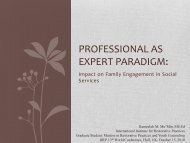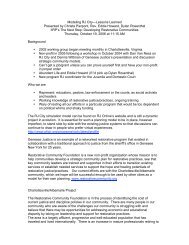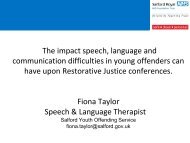Between Wholeness and Restoration - IIRP
Between Wholeness and Restoration - IIRP
Between Wholeness and Restoration - IIRP
Create successful ePaper yourself
Turn your PDF publications into a flip-book with our unique Google optimized e-Paper software.
<strong>Between</strong> <strong>Wholeness</strong> <strong>and</strong> <strong>Restoration</strong><br />
Theorizing Restorative Justice <strong>and</strong> Restorative Practice<br />
Dorothy Va<strong>and</strong>ering<br />
Ph.D. C<strong>and</strong>idate<br />
Faculty of Education<br />
University of Western Ontario
Note: This paper is currently unpublished <strong>and</strong> in draft form. If you choose to use these<br />
ideas in your work, please only refer to, copy, or quote it with my permission. I can be<br />
contacted at dva<strong>and</strong>ering@sympatico.ca. Thank-you.)<br />
Introduction:<br />
Howard Zehr (2006) was half way through his presentation on Restorative Justice<br />
when he admitted his puzzlement regarding its effectiveness. As a leading North<br />
American researcher <strong>and</strong> practitioner in the field of implementing restorative justice as an<br />
alternative to the more retributive judicial system, he acknowledged that though an<br />
effective model had been created, he continued to be surprised to hear those who had<br />
experienced it say, “Restorative justice has changed my life!” Why is it that Restorative<br />
justice changes lives he asked. In other words, he was reiterating what Marshall (1999)<br />
stated seven years earlier in an overview of theories related to restorative justice, “as it<br />
currently st<strong>and</strong>s, Restorative Justice still lacks a definitive theoretical statement …<br />
whether it is capable of becoming more than just a model of practice <strong>and</strong> becoming a<br />
complete theory of justice remains to be seen” (p. 30).<br />
Ted Wachtel (2003) who saw the potential for taking the principles of restorative<br />
justice into educational institutions has grappled with this need for theory <strong>and</strong> along with<br />
Paul McCold (2003) has put forth a conceptual theory of restorative justice that has<br />
grown overtime to include 3 conceptual structures: a social discipline window,<br />
stakeholder roles, <strong>and</strong> a restorative practice typology (p. 1). Yet after a thorough<br />
description of each, they conclude that their framework provides comprehensive answers<br />
for the how, what <strong>and</strong> who of restorative justice (p. 3) leaving me to realize that like Zehr<br />
<strong>and</strong> Marshall, finding the answer to “why” continues to be a challenge.
Because I believe, like Wachtel <strong>and</strong> others, that restorative justice holds potential for<br />
transforming educational environments, the purpose of my paper is to explore this gap in<br />
underst<strong>and</strong>ing <strong>and</strong> perhaps come a step closer to finding an answer to ‘why’. In so doing,<br />
there is a greater hope that restorative justice will become a way of life rather than a<br />
model or a series of strategies that stay inside the classroom or courtroom. I will begin by<br />
describing restorative justice principles <strong>and</strong> how they are being implemented in schools<br />
through the broader emerging field of restorative practices. Then by examining the roots<br />
of Zehr <strong>and</strong> Wachtel’s ideas I hope to identify among other things the worldview/view of<br />
the person that has influenced the models they have developed. From here I ask a series<br />
of critical questions that will lead into an exploration of my own ideas, illuminated by the<br />
work of Freire (1970) <strong>and</strong> hooks (2003), as I attempt to answer the question “why is<br />
restorative practice effective in educational institutions” Though I do not expect to<br />
uncover what has puzzled many for several decades, I do consider that my grappling is an<br />
early step to further research I hope to carry out regarding the successful implementation<br />
of restorative justice principles in elementary <strong>and</strong> high schools.<br />
In many ways I consider this paper to be a conversation in the spirit familiar to<br />
restorative justice. The conversations that are the vehicles for bringing about restoration<br />
in conflict situations are held in what Kay Pranis <strong>and</strong> others have called Peacemaking<br />
Circles. Pranis (2005) who has articulated the essential role community plays in<br />
restorative justice has identified a variety of types of circles depending on the<br />
circumstances. One of them, the Talking Circle, with a little imagination, provides a<br />
structure for this paper:<br />
In a Talking Circle, participants explore a particular issue or topic<br />
from many different perspectives. Talking Circles do not attempt to
each consensus on the topic. Rather they allow all voices to be<br />
respectfully heard <strong>and</strong> offer participants diverse perspectives to<br />
stimulate their reflections.” (p. 14)<br />
Through this paper I envision the bringing together in a circle a variety of people who can<br />
inform the development of a comprehensive theory of restorative justice. Each gives<br />
voice to a particular perspective. In such a way, the conversation regarding a theoretical<br />
framework will be stimulated to better underst<strong>and</strong> why it is that restorative practices<br />
change peoples’ lives.<br />
The Principles of Restorative Justice <strong>and</strong> Restorative Practice<br />
Restorative Justice began anew in the 1970’s as an attempt to address limitations <strong>and</strong><br />
needs in the current criminal justice system in the Western world. I use the word anew to<br />
indicate that the principles of restorative justice in <strong>and</strong> of themselves are not new <strong>and</strong><br />
have been the cornerstone of many non-Western, indigenous cultures <strong>and</strong> various<br />
religions from their beginnings. However, “during colonization, the Western legal model<br />
often condemned <strong>and</strong> repressed traditional forms of justice” (Zehr, 2002, p. 43,) <strong>and</strong><br />
became the dominant manner in which justice was carried out <strong>and</strong> often understood. The<br />
Western legal model that restorative justice calls into question can best be described as a<br />
retributive model that focuses on the responsibility of the state to punish offenders of<br />
justice in such a way that the public perceives that the guilty get what they deserve for the<br />
crime committed <strong>and</strong> believe justice has been done. Proponents of restorative justice<br />
point out that this process of justice does not contribute to healing or peace but rather<br />
deepens societal wounds <strong>and</strong> conflicts (p. 3). In its stead restorative justice presents an<br />
alternative that focuses on repairing the harm done to people <strong>and</strong> relationships.
Zehr (2002) identifies three foundational principles of restorative justice (p. 22-24):<br />
• Crime is a violation of people <strong>and</strong> of interpersonal relationships: Where the<br />
current legal system focuses on the law that is broken, restorative justice looks<br />
first at who has been hurt. The primary concern is for the victims <strong>and</strong> their needs<br />
recognizing that the communities involved as well as the offenders themselves<br />
have concerns that need to be addressed. In this way the root cause of the<br />
occurrence is addressed <strong>and</strong> an experience of healing is possible for all<br />
concerned.<br />
• Violations create obligations to put things right: The current legal system<br />
highlights the guilt of the offender <strong>and</strong> feels justice is upheld if it can be shown<br />
that appropriate punishment has been meted out. Restorative justice identifies<br />
that offenders who have caused harm have obligations <strong>and</strong> are accountable <strong>and</strong><br />
responsible to make things right for the victim. However, restorative justice also<br />
identifies that the community is a stakeholder in the events that have occurred<br />
<strong>and</strong> as such have obligations to both the offenders <strong>and</strong> the victims.<br />
• <strong>Restoration</strong> requires engagement: Currently the traditional legal system in its<br />
zeal to dole out deserving punishments, takes ownership of the offence after<br />
charges have been laid (offence against the state) withdrawing opportunities for<br />
the victim, offender <strong>and</strong> the community to have a significant voice in resolution.<br />
Restorative justice recognizes that if repair <strong>and</strong> healing are to occur the voices of<br />
the victim, offender <strong>and</strong> community members’ must be heard so all three can be<br />
engaged actively in finding places of healing. The state’s role changes to being<br />
one of facilitating the process of restoration.
In summary, Zehr defines restorative justice in a criminal justice setting as<br />
“a process to involve, to the extent possible, those who have a stake in<br />
a specific offence <strong>and</strong> to collectively identify <strong>and</strong> address harms,<br />
needs, <strong>and</strong> obligations, in order to heal <strong>and</strong> put things as right as<br />
possible” (Amstutz <strong>and</strong> Mullet, 2005, p. 15).<br />
Ted Wachtel, an American educator who used restorative justice principles<br />
successfully in a school for delinquent youth, has been a leader in seeing its potential for<br />
educational institutions of all kinds. Initially after using formal restorative justice<br />
conferences that included the victims, offenders <strong>and</strong> their supporting community<br />
members for serious incidents of wrongdoing, he began to realize “a restorative school<br />
climate requires more than just formal restorative processes like conferencing. We will<br />
need to employ informal restorative practices as well—integrated systematically as part<br />
of everyday school life” (Wachtel (1999, p. 2). This expansion which included a<br />
continuum of practices to promote a supportive, yet limit-setting environment was<br />
dubbed restorative practices. The foundational principles, like those of restorative<br />
justice, aim to repair the harm done to people <strong>and</strong> relationships. However, Wachtel, in<br />
pulling the emphasis away from an environment of criminal justice has identified the<br />
underlying hypothesis of restorative practice to be “that human beings are happier, more<br />
cooperative <strong>and</strong> productive, <strong>and</strong> more likely to make positive changes in behaviour when<br />
those in positions of authority do things with them, rather than to them or for them” (p. 1,<br />
What is …). The continuum of practices where teachers engage with students who have<br />
harmed <strong>and</strong> are harmed includes several fundamental elements:<br />
• Foster awareness: affective statements or questions by the teacher<br />
addressed to the offending students draw attention to how their behaviour<br />
has impacted others around them. Empathy is then possible.
• Avoid scolding or lecturing: these result in defensive reactions on the part<br />
of the misbehaving students <strong>and</strong> close down opportunities for repair of<br />
harm done.<br />
• Involve students actively: dialoguing between the harmed <strong>and</strong> those who<br />
have harmed provides opportunities for accountability. No longer is<br />
punishment given to the students who have no option but to be passive,<br />
but all involved work with each other to repair problems.<br />
• Accept ambiguity: all situations of wrong-doing are not clear. Restorative<br />
practices allow for all involved to recognize the complexity of the<br />
situations relieving the need to find <strong>and</strong> place blame. Restorative action<br />
can still be taken.<br />
• Separate the deed from the doer: restorative practice recognizes students’<br />
worth <strong>and</strong> disapproves only of their wrongdoing.<br />
• Every wrongdoing or conflict is an opportunity for learning: negative<br />
incidents are turned into constructive events that have the potential to<br />
build empathy <strong>and</strong> community.<br />
Amstutz <strong>and</strong> Mullet (2005) in Restorative Discipline for Schools summarize this<br />
restorative school environment by building onto Zehr’s definition of restorative justice<br />
stated earlier:<br />
“Restorative [discipline] promotes values <strong>and</strong> principles that use<br />
inclusive, collaborative approaches for being in community. These<br />
approaches validate the experiences <strong>and</strong> needs of everyone within the<br />
community, particularly those who have been marginalized, oppressed<br />
or harmed. These approaches allow us to act <strong>and</strong> respond in ways that<br />
are healing rather than alienating or coercive.” (Amstutz <strong>and</strong> Mullet,<br />
2005, p. 15)
They then provide seven markers of restorative practice (p. 29-32) that incorporate<br />
Wachtel’s principles. Does the practice:<br />
• Focus primarily on relationships <strong>and</strong> secondarily on rules<br />
• Give voice to the person(s) harmed<br />
• Give voice to the person(s) who caused the harm<br />
• Engage in collaborative problem-solving<br />
• Enhance responsibility<br />
• Empower change <strong>and</strong> growth<br />
• Plan for restoration<br />
In this overview of the principles of restorative justice <strong>and</strong> restorative practice it is<br />
important to note that the common element between the two is not necessarily a shared<br />
underst<strong>and</strong>ing of justice as much as it is a shared underst<strong>and</strong>ing of restoration.<br />
Restorative justice examines how justice can bring about restoration whereas restorative<br />
practice examines how educational practices can bring about restoration. The distinction<br />
may be subtle but it directs attention away from the act of wrongdoing <strong>and</strong> the need to<br />
find fault <strong>and</strong> focuses instead on the resulting harm <strong>and</strong> the potential for healing. In this<br />
way, blame takes a back seat to hope. Having said this, an underst<strong>and</strong>ing of justice is still<br />
relevant for both when I consider it in light of Wolterstorff’s (2005) underst<strong>and</strong>ing of<br />
primary justice. In his suggestion that “… justice is present when no one is wronged”<br />
<strong>and</strong> thereby “justice places in the forefront of our attention the worth of the other” (p. 13)<br />
the st<strong>and</strong>ards for wholeness in restorative justice or restorative practice can be found. It<br />
answers the question, how can I know when restoration is necessary --When the worth<br />
of the other has been diminished. This identification of brokenness must occur before it<br />
is possible to underst<strong>and</strong> restoration.<br />
As I grapple with why restorative practices are effective in educational institutions, I<br />
shift my focus from ‘what is justice’ to ‘what is restoration’ by accepting that justice<br />
maintains that all people are of equal worth <strong>and</strong> then training my focus on what it means
to be restored to that state of being. This is key not only for my own underst<strong>and</strong>ing but<br />
also as I examine the theoretical efforts of people like Zehr <strong>and</strong> Wachtel who are<br />
involved in the practice of restorative principles.<br />
Theorizing Restorative Justice<br />
Restorative justice is a relatively new field of research where only a few have<br />
attempted to draw up theories that could explain why it has the impact it does. Zehr,<br />
despite his puzzlement, does begin the process of what LeCompte & Preissle (cited in<br />
McCotter, 2001, p. 3) call theorizing. “Theories are human constructions: they are<br />
derived from information which people collect by seeing, hearing, touching, sensing,<br />
smelling, <strong>and</strong> feeling” (p. 120). Zehr’s writing, photography, <strong>and</strong> speaking indicate that<br />
truly he has used all of these senses in his participation in restorative justice experiences<br />
however, he is reluctant to develop any “interrelated sets of assumptions, concepts <strong>and</strong><br />
propositions that constitute a view of the world” (p. 120) until more of the stories that<br />
relate how restorative justice can go wrong are exposed. “We have to talk about both<br />
kinds of stories; we need to be clear,” he states before he feels he has an answer to why it<br />
is that restorative justice changes lives positively (Zehr, 2006). I respect his need to do<br />
more comprehensive research, however, because theory is not intended to be definitive<br />
many of his ideas are theoretical stepping stones that will allow him or others to further<br />
develop these theories of restorative justice. Sarason’s definition of theory (cited in<br />
McCotter, 2001, p. 3) also confirms Zehr’s work as theorizing. “Theory is a necessary<br />
myth that we construct to underst<strong>and</strong> something we know we underst<strong>and</strong> incompletely”<br />
(p. 3).
With this in mind, I will examine Zehr’s incomplete underst<strong>and</strong>ing <strong>and</strong> attempt to<br />
identify his “interrelated sets of assumptions, concepts <strong>and</strong> propositions that constitute a<br />
view of the world” (p. 120) keeping in mind his recognition that “many issues remain<br />
undeveloped <strong>and</strong> unanswered” (Zehr, 2005, p. 221).<br />
Zehr (2005) repeatedly contrasts restorative justice with retributive justice. Though he<br />
indicates that within restorative justice there may on occasion be a need for retribution (p.<br />
221), he tends to talk about the two as distinctly different ways of thinking or paradigms.<br />
In his search for theory he questions if this is really the case. What then is this way of<br />
thinking By looking more closely at the three foundational principles of restorative<br />
justice that Zehr has laid out, this paradigm becomes clearer. In the first restorative<br />
justice principle, crime is a violation of people <strong>and</strong> of interpersonal relationships, Zehr<br />
reveals his belief that people <strong>and</strong> their relationships have worth <strong>and</strong> this worth can be<br />
damaged or destroyed. He also believes that people have the potential of living in<br />
circumstances with others where they are safe from harm. In his acknowledgment of the<br />
worth of relationships, community is assumed; however, he is well aware that<br />
“community is an elusive, oft-abused term. What does it mean <strong>and</strong> how could it be given<br />
reality in a restorative approach” (emphasis in original, p. 221). In the second restorative<br />
justice principle, violations create obligations to put things right, Zehr uncovers his belief<br />
that it is not only possible to right the wrongs committed, it is our responsibility as<br />
humans to protect the worth of others <strong>and</strong> their relationships. Also inherent in this<br />
statement is a recognition that putting things right requires looking at the cause of the<br />
situation <strong>and</strong> identifying that those who have violated others, may themselves have needs<br />
that the larger community must address. In the third restorative justice principle,
estoration requires engagement, Zehr identifies that without dialogue of some sort<br />
between the parties involved, there cannot be restoration. Hearing each other’s stories<br />
allows for underst<strong>and</strong>ing to grow between those involved. Inherent in this is a perception<br />
of community being people who care for <strong>and</strong> support each other.<br />
For Zehr (2005), this restorative paradigm, is further rooted in a Judeo-Christian<br />
tradition that identifies shalom as the basic core belief out of which all other Christian<br />
beliefs (salvation, atonement, forgiveness <strong>and</strong> justice) grow. Shalom which is often<br />
understood as ‘peace’ is more accurately translated to be “a condition of ‘all rightness,’<br />
of things being what they should be” (p. 130) which corresponds to Wolterstorff’s (2005)<br />
definition of primary justice “… justice is present when no one is wronged” (p. 13).<br />
Zehr acknowledges that this is contrary to the thought that many have regarding<br />
Christianity being the root out of which the paradigm of retribution has grown (an eye for<br />
an eye) <strong>and</strong> carefully lays out how this is a misinterpretation of scripture. Although this<br />
Judeo-Christian tradition is where Zehr locates himself, his work <strong>and</strong> the work of many<br />
others (Llewelyn & Howse, 1998; Morrison, 2002; Blue & Blue 2001) recognize that this<br />
sense of shalom/primary justice is not unique to Christianity <strong>and</strong> can be found in<br />
indigenous cultures <strong>and</strong> other religions.<br />
One final observation that uncovers something of Zehr’s underst<strong>and</strong>ing of power can<br />
be found in his assessment that retributive justice emerged in Western civilizations as a<br />
result of the emerging state’s need to monopolize <strong>and</strong> exercise its power to give it<br />
legitimacy (Zehr, 2005, p. 125). By identifying this possible reason for the rise of a<br />
retributive justice system, Zehr indicates that for restorative justice to be effective, power<br />
is most beneficial or productive when it is shared as a tool in the h<strong>and</strong>s of all those
directly affected. Though he tends not to elaborate on this concept, British researcher<br />
Charles Barton (2003), in response to viewing restorative justice in opposition to<br />
retributive justice, chooses instead to theorize further on the possibility that restorative<br />
justice is grounded in a theory of empowerment. In my opinion, Zehr would not oppose<br />
Barton’s ideas but see them as an extension of his own.<br />
In summary then, within this paradigm what theory of restorative justice emerges I<br />
would infer that Zehr believes restorative justice changes lives because people inherently<br />
know their sense of wholeness <strong>and</strong> worth is dependent on their relationships with others.<br />
When they have been violated, they desire shalom, which can only occur through dialog<br />
which creates the space required for the worth of all involved to be revealed to each<br />
other. After examining Zehr’s work closely, I might also conclude that though he is<br />
credited with developing the traditional underst<strong>and</strong>ing of restorative justice by<br />
contrasting it to retributive justice, his heart seems more attuned to a notion of restorative<br />
justice being grounded in a theory of relationship/community.<br />
Theorizing Restorative Practices<br />
Restorative practices, having grown out of the field of restorative justice, is a very<br />
young in terms of being a field of research. Ted Wachtel, one of the earliest researchers<br />
involved in developing the concept of restorative practices, first began writing about it in<br />
1997 after he observed some early stages of its use in Australia where he reports the first<br />
restorative family group conference took place in a school in 1994 (Wachtel, 1997, p.<br />
124). In desiring to prevent serious wrongdoing in schools as opposed to the treating<br />
the results of misbehaviour he saw the need for the development of restorative school
climates that he felt were only possible if restorative practices were integrated<br />
systematically as a part of everyday school life (Wachtel, 1999, p. 2). What has resulted<br />
is a theory that explains what these practices are, who is involved, <strong>and</strong> how situations of<br />
conflict are transformed into ones of cooperation when restorative practices are<br />
employed. Throughout Wachtel (2003), locates himself in the work of other theorists<br />
who provide partial answers to why restorative practices may be effective in a school<br />
setting but falls short himself in articulating definitively why people respond positively to<br />
restorative practice. By examining Wachtel’s social discipline window, I will<br />
demonstrate that he believes students respond positively to restorative practice because<br />
he fundamentally believes people are relational, emotive beings whose inherent sense of<br />
worth is restored, maintained or thrives when affirmed by the trust <strong>and</strong> support of adults<br />
who are able to provide an environment of high control/high support. Without this a<br />
person’s sense of well-being is violated; with it they are restored.<br />
You messed things<br />
up. (I know better)<br />
You can do it! (I’m<br />
here to help)<br />
You aren’t worth<br />
anything to me. (I<br />
don’t care what you<br />
do.)<br />
You’re not able. (I<br />
can do it better)<br />
Fig. 1: Social Discipline Window (Wachtel, 1999, p. 2)<br />
In designing the social discipline model, Wachtel exp<strong>and</strong>s on the limited<br />
punitive/permissive model of punishment used to control wrongdoing that is evident in<br />
many schools, homes, <strong>and</strong> communities today. Instead of seeing only two response
options to misbehaviour, to punish or not to punish, he suggests a broader perspective<br />
that will encompass people’s inherent need for relationship in supporting their sense of<br />
worth as a restorative option. The permissive, neglectful, <strong>and</strong> punitive windows all are<br />
inadequate as they send messages that undermine a person’s sense of worth <strong>and</strong> wellbeing<br />
<strong>and</strong> exclude them from relationships (see arrow messages on Fig.1). The restorative<br />
window sends a message of hope for healing <strong>and</strong> provides for opportunities in which<br />
students can express their emotions, deal with their feelings, <strong>and</strong> find support for their<br />
growth in underst<strong>and</strong>ing relationships. Here teachers involve students directly in the<br />
process of discipline <strong>and</strong> when necessary include those harmed, family, peers <strong>and</strong><br />
community. How can this be done By providing an environment of high control of<br />
wrongdoing (not of people) <strong>and</strong> high support of the worth of people (Wachtel, 1999, p. 2)<br />
that says in essence, “I do not like what you are doing, but I like who you are so let me<br />
walk with you as you solve this problem.” This underst<strong>and</strong>ing is worked out in the<br />
elements of restorative practices listed on pages 5 <strong>and</strong> 6 as well on the diagram below<br />
that names five restorative practices.<br />
Figure 2: Restorative Practices Continuum (Wachtel, 1999, p. 3)<br />
These sum up briefly how a restorative environment can be established so that the<br />
most critical function of restorative practices, restoring <strong>and</strong> building relationships, are<br />
addressed (Wachtel, 2004, p. 3). The term with is essential <strong>and</strong> illustrates Wachtel’s<br />
underst<strong>and</strong>ing that humans have a need to be in relationship.
Central to opportunities given in restorative practices to build <strong>and</strong> restore is the theory<br />
that “human relationships are best <strong>and</strong> healthiest when there is a free expression of<br />
affect—or emotion … It is through the mutual exchange of expressed affect that we<br />
build community, creating the emotional bonds that tie us all together (Tomkins <strong>and</strong><br />
Nathanson cited in Wachtel 2004, p. 4).<br />
In this way restorative practices build healthy,<br />
strong relationships amongst students (<strong>and</strong> staff) equipping them with social skills<br />
necessary for conflict resolution prior to experiencing the more difficult situations that<br />
will arise.<br />
In summary then, I repeat my previous inference that Wachtel’s Social Discipline<br />
Window uncovers his theoretical framework that restorative practice changes lives<br />
because people are relational, emotive beings whose inherent sense of worth is restored,<br />
maintained or nurtured when affirmed by the trust <strong>and</strong> support of adults who are able to<br />
provide an environment of high control/high support.<br />
A Series of Critical Questions <strong>and</strong> Observations<br />
A series of critical questions <strong>and</strong> observations arise in my mind as I conclude my<br />
overview of the principles <strong>and</strong> theoretical underpinnings of restorative justice <strong>and</strong><br />
restorative practice. Earlier I indicated a need to shift my thinking from ‘what is justice’<br />
to ‘what is restoration’ <strong>and</strong> the importance of this in considering Zehr <strong>and</strong> Wachtel’s<br />
work as well. I am struck by the fact, however, that as much as both aim to address the<br />
needs of the victim <strong>and</strong> repair the harm done neither articulates their vision very well in<br />
terms of what it means for those harmed to be restored. The stories each relates of those<br />
who have experienced restoration illustrate that it is not a return to “a former or original
state” (Webster on line) or financial compensation for harm done, but rather a renewal of<br />
a relationship of trust where both parties uphold each other as worthy. I am left,<br />
however, with the questions do restorative justice <strong>and</strong> restorative practice really<br />
underst<strong>and</strong> what it means for people to be restored Would it be helpful to take a closer<br />
look at what constitutes restoration<br />
Perhaps, one way of doing this is to consider the elements of a good relationship.<br />
Here Wachtel’s Social Discipline Window may be helpful. Though Wachtel (1999) uses<br />
the social discipline window only to describe how teachers <strong>and</strong> administrators respond to<br />
the wrongdoing of students, I believe it can <strong>and</strong> should be extended to illustrate the<br />
dynamics of peer relationships as well. In wishing to establish a restorative school<br />
climate, students can discover that healthy relationships only develop when they interact<br />
with others by being supportive <strong>and</strong> encouraging while at the same time being responsive<br />
to behaviour that places their peer in harm’s way. Just as an adult can say, ‘I don’t like<br />
what you are doing, put I like who you are’ so too children <strong>and</strong> youth can discern this<br />
difference. The actual restorative incidents do emphasize the engagement of students<br />
with each other but always in the presence of an adult. Not only modelling but also<br />
teaching students the dynamics of relationships may be an important step in their ability<br />
to articulate their emotions when the opportunity arises. The fact that Wachtel does not<br />
identify the correlation between the two, raises other questions. Is restorative practice<br />
truly interested in restoration of relationships or is it more interested in providing a means<br />
for controlling student behaviour Though I have inferred the former for good reasons,<br />
without articulating clearly the underlying framework of the inherent worth of humanity,<br />
the reforms Wachtel suggests run the risk of being derailed.<br />
Perhaps some of this is
already visible in the fact that the emphasis in his ideas is regularly on the one who has<br />
caused the harm, not the needs of the one harmed as the underlying principles of<br />
restorative practice state, as well as the fact that he never gives a clear description of what<br />
restoration really entails.<br />
Further along this line of thinking, I begin to question whether restorative<br />
justice/restorative practice might not be a more subtle way in which to reproduce the<br />
current forms of oppression students experience in schools. Like Ellsworth who<br />
questions the practices of critical pedagogy--empowerment, student voice, dialogue—<strong>and</strong><br />
discovers that they have the potential for becoming “repressive myths that perpetuate<br />
relations of domination” (Ellsworth, 1989, p. 298), I feel restorative justice <strong>and</strong><br />
restorative practice have similar potential if practitioners are not alert to their own<br />
underst<strong>and</strong>ing of the worth of the other. In a society where the liberal view of the person<br />
is predominantly espoused, it is very possible that different ways in which people’s rights<br />
<strong>and</strong> responsibilities are understood may undermine the relational, community building<br />
that restorative justice <strong>and</strong> restorative practice depend on. I am beginning to better<br />
appreciate Zehr’s (2005) cautionary note that much conceptual work remains to be done<br />
as many issues remain undeveloped <strong>and</strong> unanswered (p. 221).<br />
In spite of these observations <strong>and</strong> questions, I continue to believe restorative practice<br />
has the potential for transforming educational environments if restoration of relationships<br />
is truly the goal. In the remainder of this paper I will present my own theory to explain<br />
why I believe restorative practice is effective in a school setting.
Where am I located<br />
My theory is not complicated. However, after mulling it over for many years, I must<br />
admit it has been somewhat hard to accept in the context of how our current liberal<br />
minded society views the individual. As a result I have put it aside on many occasions as<br />
I explored different options <strong>and</strong> pondered the work of others. I questioned its validity in<br />
light of other paradigms of thought, but as I wrote this paper, the theory emerged again<br />
<strong>and</strong> again not only in my mind but also in the manner in which it was alluded to in the<br />
writings of many others. I surrender the following not because I believe it is complete,<br />
but because in presenting it in this context I hope to further my own underst<strong>and</strong>ing of<br />
restorative practice <strong>and</strong> perhaps shed light on the work that has already been done by<br />
others. I surrender it also because like hooks (1994) I have found that theorizing is a<br />
place of sanctuary where I can imagine possible futures, a place where life could be lived<br />
differently … a healing place (p. 61). Laurel Richardson (2000) in Writing: a method of<br />
inquiry, says it is in writing that we discover what we know (p. 924), <strong>and</strong> it is my hope<br />
that as I write, my theoretical underst<strong>and</strong>ing of restorative practice will become clearer.<br />
Consider the following the beginning of a work in progress.<br />
My theory can be encapsulated in one sentence: restorative justice <strong>and</strong> restorative<br />
practice are effective simply because I believe people know that at their core they are<br />
broken. St<strong>and</strong>ing here I realize I am st<strong>and</strong>ing in a divide between what has been <strong>and</strong> what<br />
can be, a place that Palmer (1983) describes as a space in which obedience to truth can be<br />
practiced (p. 69), a gap wherein I experience the tension between reality <strong>and</strong> possibility<br />
(Palmer, 2004, p. 175).<br />
<strong>Wholeness</strong> Brokenness <strong>Restoration</strong>
When brokenness is acknowledged, restorative practice allows people the space in which<br />
they can remove their masks <strong>and</strong> see each other truthfully. In that there is relief <strong>and</strong> hope<br />
<strong>and</strong> the reason for people saying “restorative justice changed my life” (Zehr, 2006) for<br />
they have experienced the paradox of wholeness in brokenness.<br />
Because I embrace the reality of brokenness <strong>and</strong> the hope of restoration I believe I am<br />
best situated in the realm of critical theory <strong>and</strong> pedagogy where we find those who are<br />
oriented to critiquing <strong>and</strong> changing society as a whole <strong>and</strong> ultimately desiring what<br />
McLaren (1998) says is “the sensibility of the Hebrew symbol of tikkun, which means to<br />
‘heal, repair <strong>and</strong> transform the world’”(p. 164). In particular I find Paulo Freire’s focus<br />
on dialogue <strong>and</strong> praxis as well as bell hooks’ view of education as the practice of freedom<br />
most helpful in further illuminating my theory of brokenness. I find this orientation fits<br />
well into my larger view of the world which, like Zehr, holds closely to the Judeo-<br />
Christian worldview that embraces an underst<strong>and</strong>ing of shalom throughout the events of<br />
creation, fall, redemption <strong>and</strong> fulfillment.<br />
One of the reasons I initially resisted this theory of brokenness was the fear that it<br />
would be perceived as pessimistic <strong>and</strong> negative. However, as I experienced again <strong>and</strong><br />
again the hope that came from this paradox of wholeness in brokenness I realized I was<br />
caught up in the culture of fear that restorative practice seeks to alleviate. Cavanagh<br />
(2003) identifies this as the fear of making mistakes <strong>and</strong> the fear of punishment which the<br />
very structure <strong>and</strong> practice of schooling nurtures (p. 8). Palmer (1997) points out that<br />
ironically schools produce a majority of people who feel stupid <strong>and</strong> call themselves losers<br />
despite the fact that they have had many years of education. “It is a system that dissects<br />
life <strong>and</strong> distances us from the world because it is rooted in fear.” Why did I fear this
perception of pessimism Because, if rejected, I would feel less than whole, less than<br />
worthy. It would be easier to remain silent or better yet, hide by echoing the voices of<br />
others I admired. hooks (2003) shakes me from my hesitancy when she says, “This fear<br />
of being found personally wanting in some way is often one of the greatest barriers to<br />
promoting critical consciousness” (p. 107) <strong>and</strong> I reread reflections I have written in an<br />
earlier course regarding this culture of fear.<br />
Our culture is bent on preserving a wholeness that doesn’t exist.<br />
We blindly welcome advertising that claims we can have a perfect<br />
body, our cars can enhance our image, we can take a pill to loose<br />
unwanted fat or be rid of headaches. We are told the future is in our<br />
h<strong>and</strong>s, we can have freedom at age 55, beer can make us the life of the<br />
party … all such messages deceptively try to convince us that there is<br />
a better world that others live in <strong>and</strong> we should aspire to be part of it.<br />
Ironically, if we could individually stop <strong>and</strong> accept our inability to be<br />
whole <strong>and</strong> then collectively admit that we have messed up the world<br />
we live in, we may discover wholeness.<br />
What impact might such an admission of brokenness have on<br />
education As a teacher in a classroom of eight-year-old children<br />
admitting my shortcomings <strong>and</strong> acknowledging theirs as normal, could<br />
result in the walls of defensiveness tumbling down. The tendency to<br />
frantically convey an image of wholeness as a teacher or student is no<br />
longer necessary. The power of competitiveness would be disarmed<br />
for all would be valued equally. The tightly clenched fists holding on<br />
to scraps of identity would slowly be released. A space will have been<br />
created in which the sacred could be revealed <strong>and</strong> the voice of<br />
acceptance <strong>and</strong> love heard. Within this space, all inhabitants could<br />
experience “being with” each other <strong>and</strong> the subject at h<strong>and</strong>.<br />
I share these thoughts to provide a description of the setting in which restorative<br />
practice in particular finds itself <strong>and</strong> to give a personal account of how such a setting<br />
continues to impact my current efforts. I continue now by considering more closely the<br />
divide of brokenness in which I believe we all st<strong>and</strong> <strong>and</strong> how restorative practice helps to<br />
deal with the tension between what is <strong>and</strong> what could be.<br />
<strong>Wholeness</strong> Brokenness <strong>Restoration</strong>
Restorative practice meets all people, those harmed, those who have harmed, <strong>and</strong> their<br />
communities at a time when they feel most vulnerable. What it provides at that moment<br />
is education as the practice of freedom (hooks, 2003, 103) wherein the twin dimensions<br />
of a true word, action <strong>and</strong> reflection, are spoken <strong>and</strong> transformation (Freire, 1970, p. 87)<br />
is possible. At this time <strong>and</strong> in this place, participants catch a glimpse of the wholeness<br />
<strong>and</strong> worth they recognize as what was once their birthright <strong>and</strong> long for the healing that<br />
they can only now imagine. Desperate for peace, they come to share their pain. hooks<br />
(2003) describes this moment <strong>and</strong> the critical role of the teacher in a chapter entitled<br />
Moving beyond shame.<br />
“Students in crisis recover themselves only when there are<br />
progressive educators who give them space to feel their shame,<br />
express those feelings, <strong>and</strong> do the work of healing. … Kaufman <strong>and</strong><br />
Raphael remind us that ‘all human beings st<strong>and</strong> equal in the sudden<br />
exposure wrought by shame.’ They state: ‘Shame shadows each of us,<br />
<strong>and</strong> everyone encounters the alienating effect in some form, at some<br />
time. Entering that experience long enough to endure it, deliberately,<br />
<strong>and</strong> consciously in order to transform it, is a challenge which knows<br />
no bound. Yet only by facing that challenge can we ever hope to recreate<br />
who we are.’ … Shame dehumanizes. … As teachers we can<br />
make the classroom a place where we help students come out of<br />
shame. We can allow them to experience their vulnerability among a<br />
community of learners who will dare to hold them up should they<br />
falter or fail when triggered by past scenarios of shame—a community<br />
that will constantly give recognition <strong>and</strong> respect” (p. 102-103).<br />
Though this restorative time is pregnant with potential healing, it is also ripe for<br />
disaster as the very nature of each involved is laid bare. Here Freire (1970) provides<br />
insight <strong>and</strong> a challenge to dig into the gift of true dialogue where the word = work =<br />
praxis, where reflection <strong>and</strong> action in radical interaction, is needed (p. 87). Without<br />
reflection, restorative practice will turn into activism, without action it will turn into<br />
verbalism (p. 87), <strong>and</strong> once more an opportunity for education as a practice of freedom
will become a ‘death-dealing’ instrument (Palmer, 1997, p. 2) where the tension<br />
experienced in the gap of brokenness will become too great <strong>and</strong> all hope <strong>and</strong> potential for<br />
restoration will be lost. Because restorative practices depend on dialogue, Freire’s<br />
suggestions must be taken into account. Consider the following as you imagine being<br />
present in a restorative circle conference where those harmed, those who caused the harm<br />
<strong>and</strong> their communities are gathered.<br />
Freire (1970) begins by defining dialogue as the “encounter between men [sic],<br />
mediated by the world, in order to name the world” (p. 88) where naming is an essential<br />
human activity that results in transformation. In a restorative practice circle, stories are<br />
told for all to hear that name the experiences of pain in hope of change. Second, Freire<br />
suggests that dialogue can only exist in the presence of a profound love for the world <strong>and</strong><br />
for people. Though in restorative practice there may be much that indicates the opposite,<br />
voluntarily coming together speaks to the fact that people have a deep appreciation <strong>and</strong><br />
love for the wholeness that their brokenness has marred. Third, Freire points out that<br />
dialogue is only possible with humility. Circle participants cannot dialogue if they<br />
“always project ignorance onto others <strong>and</strong> never perceive [their] own” (p. 90). Again<br />
though the circles may begin with participants refusing to be humble, perhaps one of the<br />
most profound experiences in restorative conference is the emerging awareness on the<br />
part of both those harmed <strong>and</strong> those who have harmed that the other is also broken <strong>and</strong><br />
needy. Again <strong>and</strong> again, the stories Zehr (2005) <strong>and</strong> Wachtel (1997) relate point to this<br />
discovery <strong>and</strong> perhaps it is this that ultimately confirmed for me the need to explore<br />
further my theory of brokenness. In the moment where this becomes clear, the<br />
participants discover that they are st<strong>and</strong>ing on equal ground, <strong>and</strong> the masks that they have
spent a life time constructing to hide their various inadequacies fall away. There is<br />
incredible freedom when a community of broken people give up trying to hide from each<br />
other. Fourth, Freire explains that to speak a true word requires ‘an intense faith in<br />
humankind, faith in their power to make <strong>and</strong> remake, to create <strong>and</strong> recreate, faith in their<br />
vocation to be more fully human” (p. 90). In restorative practice this is symbolized by<br />
the willingness of individuals to participate. If they did not believe people could change<br />
there would be no reason to come face to face. Coming from a Judeo-Christian tradition,<br />
which Freire also comes from, I would distinguish this intense faith in humankind as<br />
being distinctly different from faith in God. Paradoxically, the hope that comes from faith<br />
in each other as humans is a faith that underst<strong>and</strong>s each others ability to trust, yet accepts<br />
that each continues to be fallible. Restorative practice allows for trust to develop out of<br />
this underst<strong>and</strong>ing of our common limitations as humans, our brokenness. Finally, Freire<br />
explains that dialogue requires that participants “engage in critical thinking—thinking<br />
that does not separate itself from action, but constantly immerses itself in temporality<br />
without fear of the risks involved” (p. 92).<br />
Those who participate in restorative practice<br />
st<strong>and</strong> in the gap of brokenness because they are willing to acknowledge that their<br />
experience either as one harmed or one who has harmed cannot be separated from how<br />
they will live in the future. Unwilling to carry their pain alone, they act <strong>and</strong> risk reaching<br />
out for restoration. What happens when this true dialogue occurs in a restorative<br />
experience Just as Freire explains that education cannot be carried on by “A” for “B” or<br />
by “A” about “B”, but rather by “A” with “B”, so true restorative dialogue releases<br />
people from their culture of fear <strong>and</strong> efforts at domination, to be with each other. In this<br />
way the broken parts come together in community <strong>and</strong> find that jointly they have a
greater recollection of what it was to be whole. As they simultaneously reach out for<br />
restoration, original individual wholeness <strong>and</strong> worth that has been broken is replaced by a<br />
wholeness that begins to grow because broken pieces choose to walk with each other for<br />
a time. This according to Palmer (1983) <strong>and</strong> hooks (2003) is education that practices<br />
love, education as a practice of freedom—“The goal of a knowledge arising from life is<br />
the reunification <strong>and</strong> reconstruction of broken selves <strong>and</strong> worlds. … In such knowing we<br />
know <strong>and</strong> are known as members of one community …” (p. 132).<br />
Conclusion<br />
Theory, according to Thomas (1997), is used to mean many different things in<br />
education <strong>and</strong> as a result causes confusion, discourages diversity of thought, <strong>and</strong> is<br />
overall of little use in moving educational underst<strong>and</strong>ing forward (p. 75, 84). Though I<br />
have encountered the oblique nature of theory in examining the theoretical foundations of<br />
restorative justice <strong>and</strong> restorative practice in this paper, in the end I would be hesitant to<br />
support his statements. Working to uncover the theories Zehr <strong>and</strong> Wachtel use <strong>and</strong> then<br />
trying to articulate my own underst<strong>and</strong>ing of why it is restorative practice <strong>and</strong> restorative<br />
justice are effective, requires that I question <strong>and</strong> critique the foundational elements found<br />
in each. Several benefits arise out of this. Had I not done this, I would be subject to<br />
taking things for granted that might be instrumental in the success or failure of restorative<br />
practice <strong>and</strong> restorative justice; I would not be able to see how our theories overlap <strong>and</strong><br />
support each other; <strong>and</strong> moving the theoretical underst<strong>and</strong>ing forward would be a much<br />
slower process. I would say that theory does not discourage a diversity of thought but<br />
rather serves as a place for examining diversity of thought <strong>and</strong> then becomes a
springboard for deeper underst<strong>and</strong>ing. I do agree with Thomas however, that academic<br />
theorizing runs the risk of being useless if researchers succumb to being in thrall only<br />
with the thought of theory <strong>and</strong> not its use. To prevent this I think it is important to join<br />
hooks (1994) <strong>and</strong> Lather (1986) who call for embedding theory in everyday life. “Any<br />
theory that cannot be shared in everyday conversation cannot be used to educate the<br />
public” (hooks, 1994, p. 64). As I consider the work of those who have begun to theorize<br />
restorative practice <strong>and</strong> restorative justice <strong>and</strong> sense for myself through my own ideas<br />
how deeply woven the theories are in everyday experiences, having explored theory as I<br />
have in this paper will equip me for using it in everyday conversations with people who<br />
are searching for how we might all live with a clearer image of our identity <strong>and</strong> with a<br />
greater sense of integrity.<br />
As I near the end of my grappling for a theory of restorative practice I return to the<br />
question “what is restoration” <strong>and</strong> conclude that my theorizing has brought me closer to<br />
an answer simply because I acknowledge <strong>and</strong> accept the place of brokenness. Though<br />
still not as clear as it might be, without first acknowledging its reality, restoration cannot<br />
be clearly defined. By stating “restorative justice <strong>and</strong> restorative practice are effective<br />
simply because I believe people know that at their core they are broken” restoration<br />
becomes the sense of relief that grows as the broken beings that we are reach out to<br />
affirm each other’s worth regardless of what we find. This is the experience of with, the<br />
experience of restorative practice <strong>and</strong> restorative justice, life changing events that<br />
announce:<br />
We are one, after all, you <strong>and</strong> I;<br />
Together we suffer,<br />
Together exist,<br />
And forever will recreate each other.<br />
Pierre Teilhard De Chardin
References<br />
Amstutz Stutzman, L. <strong>and</strong> Mullet, J. (2005). The little book of restorative discipline for<br />
schools. Intercourse, PA: Good Books.<br />
Barton, C. Theories of restorative justice. Retrieved February 2006 from<br />
http://www.restorativejustice.org/articlesdb/articles/2058<br />
Blue, A., & Blue, M. (2001). The case for aboriginal justice <strong>and</strong> healing: The self<br />
perceived through a broken mirror. In M. Hadley (Ed.), The spiritual roots of<br />
restorative justice (pp. 57-80). Albany: State University of New York Press.<br />
Cavanagh, T. (2003). Creating a culture of care in an elementary school: lessons<br />
learned from the children. Paper presented at NNER Annual Conference: Oct. 9-<br />
11, 2003, Salt Lake City, Utah.<br />
Ellesworth, E. (1989) Why doesn’t this feel empoweringWorking through the<br />
repressive myths of critical pedagogy. Harvard Educational Review 59 (3), pp.<br />
297-324.<br />
Freire, P. (1970). Pedagogy of the Oppressed (30 th Edition). New York: Continuum<br />
International Publishing Group Inc.<br />
hooks, b. (1994). Teaching to transgress. New York: Routledege.<br />
hooks, b. (2003). Teaching community: a pedagogy of hope. New York: Routledege.<br />
Lather, P. (1994). Critical inquiry in qualitative research: Feminist <strong>and</strong> poststructural<br />
perspectives: Science ‘after truth.’ In B. Crabtree, et. al. (eds.), Exploring<br />
collaborative research in primary care (p. 103-114). New York: Sage.<br />
Leadingham, C., Moschella, J. & Varanian, H. (1992). Peace prayers: meditations,<br />
affirmations,invocations, poems, <strong>and</strong> prayers for peace. San Francisco:<br />
HarperSanFrancisco.<br />
Llewellyn, J., & Howse, R. (1998). Restorative justice: A conceptual framework<br />
(Prepared for the Law Commission of Canada) Retrieved Monday, December 6,<br />
2005 from the worldwide web<br />
http://www.lcc.gc.ca/research_project/sr/tj/rp/howse/howse_toc-en.asp<br />
Marshall, T. (1999). Restorative Justice: an overview. Retrieved February 2006 from<br />
http://www.homeoffice.gov.uk/rds/pdfs/occ-resjus.pdf<br />
McLaren, P. (1998). Life in schools: an introductions to critical pedagogy in the<br />
foundations of education. New York: Longman
McCold, P. <strong>and</strong> Wachtel, T. (2003). In pursuit of paradigm: a theory of restorative<br />
justice. Restorative Practices E-Forum. Retrieved February 2006 from<br />
http://www.realjustice.org/library/paradigm.html<br />
McCold, P. <strong>and</strong> Wachtel, T. (2004). From restorative justice to restorative practice:<br />
exp<strong>and</strong>ing the paradigm. Paper presented at <strong>IIRP</strong>’s fifth International Conference<br />
on Conferencing, Circles <strong>and</strong> Restorative Practices: August 2004, Vancouver,<br />
British Columbia.<br />
McCotter, S. (2001). The Journey of a Beginning Researcher. The Qualitative Report,<br />
6(2). Retrieved December 2005 from http://www.nova.edu/ssss/QR/QR6-<br />
2/mccotter.html<br />
Morrison, B. (2002, October). Restorative Justice <strong>and</strong> School Violence: Building theory<br />
<strong>and</strong> practice. Restorative Practices E-Forum. Retrieved February 2006 from<br />
http://www.realjustice.org/library/morrison_bullying.html<br />
Palmer, P. (1997) The Grace of Great Things: Recovering the Sacred in Knowing,<br />
Teaching, <strong>and</strong> Learning. Retrieved May 2004 from<br />
http://www.couragerenewal.org/q=resources/writings/grace<br />
Palmer, P. (1983). To know as we are known. California: HarperSanFrancisco<br />
Palmer, P. (2004). A hidden wholeness: the journey toward an undivided life. San<br />
Francisco: Jossey-Bass.<br />
Pranis, K., Stuart, B., Wedge, M. (2003). Peacemaking circles: from crime to community.<br />
Minnesota: Living Justice Press.<br />
Pranis, K. (2005). The little book of circle process:a new/old approach to peacemaking.<br />
Pennsylvania: Good Books.<br />
Richardson, L (2000). Writing: a method of inquiry. In N. Denezin & Y. Lincoln (eds.),<br />
H<strong>and</strong>book of Qualitative Research (pp. 923-948), California: Sage.<br />
Thomas, G. (1997). What’s the use of theory Harvard Educational Review 67 (1) pp.<br />
75-104<br />
Wachtel, T. (1999). SaferSanerSchools: Restoring Community in a Disconnected World.<br />
Bethlehem, PA: SaferSanerSchools. Retrieved May, 2001,<br />
Wachtel, T. (1997). Real Justice. Pennsylvannia: Piper’s Press.<br />
Wolterstorff, N. (2005). Teaching justly for justice. Conference on spirituality, justice,<br />
<strong>and</strong> pedagogy, Gr<strong>and</strong> Rapids, MI,
Zehr, H. (2002). The little book of restorative justice. Intercourse, PA: Good Books.<br />
Zehr, H. (1985). Retributive justice, restorative justice (Occasional Paper. Kitchener, ON:<br />
Mennonite Central Committee, Canada Victim Offender Ministries.<br />
Zehr, H. (2006). Presentation given at Redeemer University College, Ancaster, Ontario,<br />
March 7, 2006.


